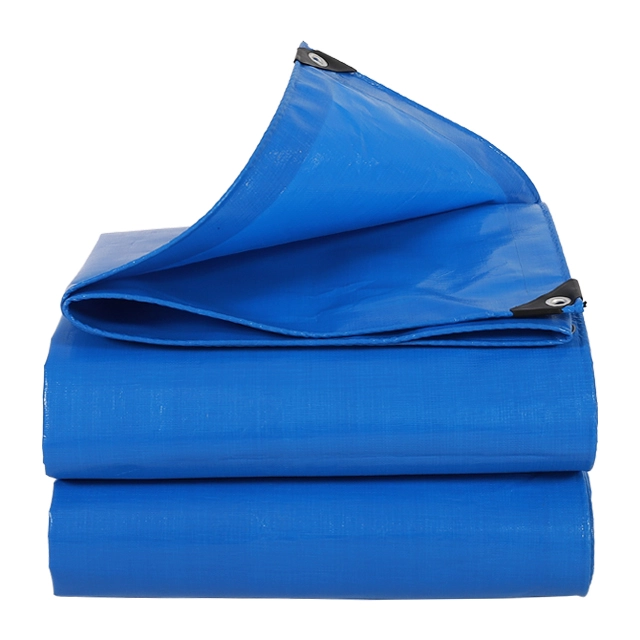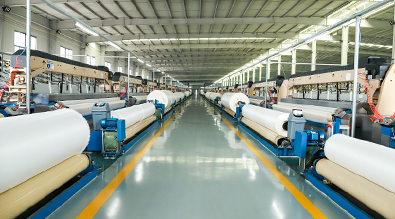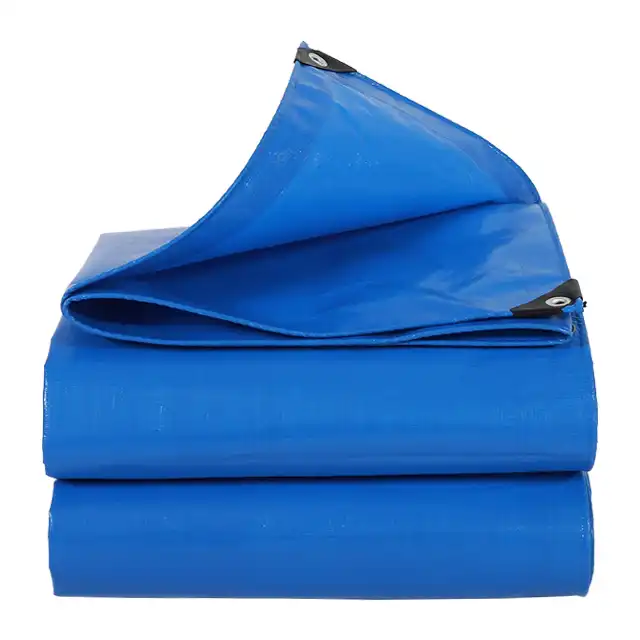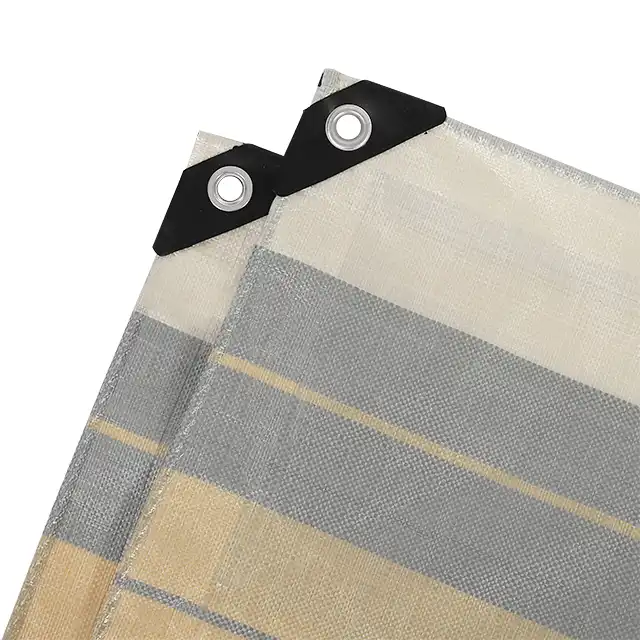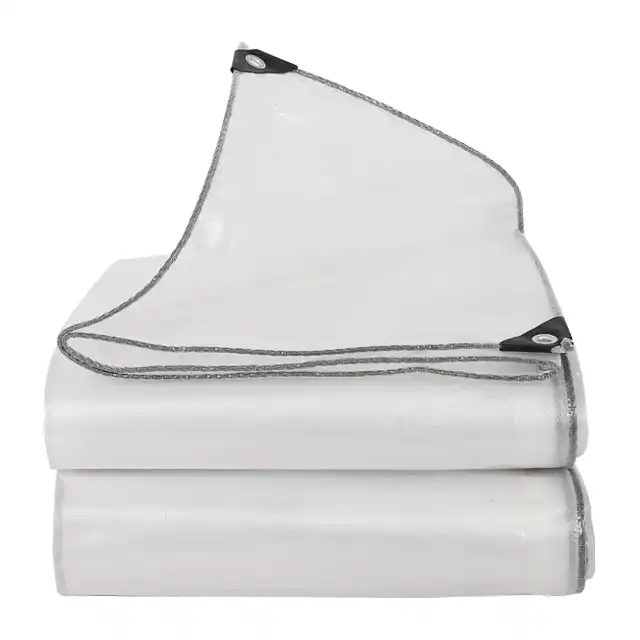The Best Roof Tarps for Emergency Leak Repair
When emergency roof leaks strike, having the right tarp can mean the difference between minor repairs and catastrophic water damage. The best roof tarps for emergency leak repair combine waterproof protection with exceptional durability, featuring materials like high-density PE tarpaulin that provide immediate coverage while withstanding harsh weather conditions. Professional contractors recommend polyethylene tarps for their superior strength-to-weight ratio, UV resistance, and ability to create an effective moisture barrier. Emergency situations demand tarps that deploy quickly yet maintain long-term reliability until permanent repairs can be completed.
Understanding Emergency Roof Tarp Requirements

Material Composition and Durability Standards
Emergency roof tarps must withstand extreme conditions while providing immediate protection against water infiltration. High-quality PE tarpaulin represents the gold standard for emergency roofing applications due to its exceptional material properties and engineering specifications. The construction involves high-density polyethylene fibers woven into a tight fabric matrix, then laminated with low-density polyethylene coating on both surfaces. This dual-layer construction creates a waterproof barrier that resists tearing, puncturing, and UV degradation even under severe weather conditions. The manufacturing process for premium PE tarpaulin involves advanced extrusion techniques that produce consistent fiber thickness ranging from 400D to 2500D, ensuring optimal strength characteristics for roofing applications. The woven structure provides multidirectional strength, while the laminated coating creates complete water impermeability. Professional-grade tarps feature reinforced edges with heat-sealed hems that prevent edge failure, a common weakness in lower-quality alternatives. The mesh count specification, typically ranging from 10x10 to 14x14, determines the tarp's flexibility and conformability to roof contours while maintaining structural integrity. Temperature resistance becomes crucial for emergency applications, as tarps may be installed during extreme weather events. Quality PE tarpaulin maintains flexibility in temperatures ranging from -40°F to 180°F, preventing cracking or brittleness during winter installations. The anti-freezing properties ensure that the material remains workable even in harsh conditions, while the arctic flexibility specification allows for proper installation without material failure. These characteristics make PE tarpaulin the preferred choice for emergency responders and roofing professionals who need reliable performance regardless of weather conditions.
Weight Classifications and Performance Metrics
The weight classification system for emergency roof tarps directly correlates with their performance capabilities and intended applications. Light-duty tarps, typically ranging from 65gsm to 100gsm, provide adequate protection for short-term emergency situations where ease of handling takes precedence over maximum durability. Medium-duty PE tarpaulin, spanning 100gsm to 180gsm, offers the optimal balance between weight and performance for most emergency roofing applications. Heavy-duty options, extending up to 280gsm, deliver maximum protection for extended coverage periods or extremely harsh conditions. The thickness specification, measured in mils (thousandths of an inch), provides another critical performance indicator. Emergency roof tarps typically range from 7 to 12 mils thickness, with each increment representing increased puncture resistance and longevity. The relationship between weight and thickness creates a performance matrix that helps determine the appropriate tarp for specific emergency scenarios. Contractors often select medium-duty tarps for residential applications, while commercial and industrial emergency repairs may require heavy-duty specifications. Performance testing reveals that properly manufactured PE tarpaulin exhibits superior tear resistance compared to alternative materials. The woven structure distributes stress across multiple fibers, preventing small punctures from propagating into large tears. This characteristic proves invaluable during emergency installations when debris, wind, or installation stresses could compromise lesser materials. Quality control measures ensure consistent performance across production batches, providing reliable protection that emergency situations demand.
UV Protection and Weather Resistance Features
Ultra-violet protection represents a critical specification for emergency roof tarps, particularly when coverage extends beyond immediate repair timelines. Professional-grade PE tarpaulin incorporates UV treatment ranging from 1% to 7% concentration, providing extended protection against solar degradation. The UV stabilizers embedded within the polymer matrix absorb harmful radiation before it can break down the molecular structure, significantly extending service life under direct sunlight exposure. Weather resistance encompasses multiple environmental factors beyond basic waterproofing. Wind resistance specifications consider both the material's ability to withstand wind loading and its resistance to wind-driven debris impact. The woven structure of quality PE tarpaulin provides superior wind resistance compared to solid film materials, as the slight porosity allows pressure equalization while maintaining waterproof characteristics through the laminated coating. This design prevents the ballooning effect that can cause catastrophic failure during high-wind events. Shrink-proof properties ensure dimensional stability across varying temperature and humidity conditions. Poor-quality tarps may shrink or stretch significantly, creating gaps or excessive tension that leads to failure. Professional PE tarpaulin maintains consistent dimensions through temperature cycling, ensuring that properly installed emergency coverage remains effective throughout changing weather conditions. Anti-corrosion properties protect metal components such as grommets and reinforcement strips, preventing premature failure of attachment points that could compromise the entire installation.
Professional Installation Techniques and Best Practices
Proper Securing Methods and Anchor Points
Effective emergency roof tarp installation requires understanding the critical relationship between attachment methods and tarp performance. The securing system must distribute loads evenly across the tarp surface while providing adequate holding strength to resist uplift forces during high-wind events. Professional installations utilize a combination of mechanical fasteners, weight distribution boards, and strategic anchor point placement to achieve optimal performance from PE tarpaulin systems. The anchor board method represents the most reliable technique for securing the ridge line of emergency roof tarps. This involves rolling the upper edge of the PE tarpaulin around a lumber board, typically 2×4 or 1×3 furring strips, creating a continuous attachment line that extends at least two feet beyond the tarp width on each side. The board provides uniform load distribution and prevents the concentrated stress that causes fastener pull-through in direct attachment methods. Proper installation requires the anchor board to be positioned on the opposite side of the roof peak from the damaged area, ensuring water runoff without creating additional penetration points. Edge securing techniques vary based on roof configuration and tarp size, but all effective methods share common principles of load distribution and redundancy. The use of furring strips along the sides creates multiple attachment points that prevent edge lifting while distributing wind loads across the tarp structure. Professional installers space fasteners at maximum 24-inch intervals, with closer spacing in high-wind areas or when using lighter-weight PE tarpaulin. The fastener selection must consider both pullout strength and sealing capabilities, as each penetration represents a potential leak point if not properly sealed.
Drainage Considerations and Water Management
Effective water management during emergency tarp installation requires careful attention to drainage patterns and runoff control. The positioning of PE tarpaulin must consider existing roof drainage systems while creating positive drainage away from damaged areas. Improper drainage can result in water pooling, which creates excessive loads on the tarp structure and may lead to catastrophic failure when the accumulated water exceeds the material's load capacity. The slope and positioning of emergency tarps should direct water toward existing gutters and downspouts whenever possible. When damage affects the normal drainage pattern, temporary drainage solutions may be necessary to prevent water accumulation behind the tarp installation. The flexibility of quality PE tarpaulin allows it to conform to roof contours while maintaining positive drainage, but installers must avoid creating valleys or depressions that could collect water. Overlap management becomes crucial when multiple tarps are required to cover large damaged areas. Professional installations ensure that upper tarps overlap lower sections by at least 12 inches, creating a shingle effect that prevents water penetration at seam lines. The overlap areas require additional securing to prevent wind-driven uplift, while maintaining the drainage pattern. Proper sealing of overlaps using compatible tape or sealants creates a continuous waterproof membrane that performs as effectively as a single large tarp.
Safety Protocols and Installation Guidelines
Emergency roof tarp installation presents significant safety challenges that require careful planning and proper equipment. Working on damaged roofs during or immediately after severe weather events compounds normal roofing hazards with unstable surfaces, debris, and potentially continuing adverse weather conditions. Professional installation teams follow strict safety protocols that prioritize both worker safety and installation effectiveness. Pre-installation assessment involves evaluating roof structural integrity, identifying safe access routes, and determining appropriate safety equipment requirements. Damaged roofing materials may not support normal loads, requiring alternative access methods or additional safety measures. The use of proper fall protection equipment becomes mandatory, with tie-off points selected based on structural integrity rather than convenience. Weather conditions must be continuously monitored, with installation suspended if conditions deteriorate beyond safe working limits. The selection of appropriate PE tarpaulin specifications must consider installation requirements as well as performance needs. Lighter-weight tarps may be preferred for difficult installation conditions, even if heavier options would provide superior long-term performance. The balance between safety and effectiveness requires professional judgment based on specific site conditions. Team coordination and communication protocols ensure that all personnel understand their roles and safety responsibilities throughout the installation process.
Long-term Performance and Maintenance Strategies
Expected Service Life and Replacement Indicators
Understanding the expected service life of emergency PE tarpaulin installations helps property owners and facility managers plan for permanent repairs while maintaining adequate protection. Quality tarps manufactured from high-density polyethylene with proper UV treatment typically provide reliable service for 6 to 12 months under normal exposure conditions. However, actual service life varies significantly based on installation quality, environmental conditions, and maintenance practices. Visual inspection protocols help identify replacement indicators before catastrophic failure occurs. Early warning signs include UV degradation evidenced by color fading or chalky surface appearance, edge fraying that could progress to larger tears, and loosening of attachment points due to material creep or fastener failure. The development of small holes or tears requires immediate attention, as these defects rapidly propagate under wind loading or thermal cycling. Professional PE tarpaulin exhibits consistent aging characteristics that allow experienced inspectors to predict remaining service life with reasonable accuracy. Environmental factors significantly influence service life expectations. Installations in high-UV environments, such as southwestern United States locations, may experience accelerated degradation compared to northern climates with less intense solar exposure. Similarly, installations subject to extreme temperature cycling, high winds, or corrosive atmospheres may require more frequent replacement. The quality of the PE tarpaulin material becomes particularly important for extended service applications, as inferior materials may fail within weeks rather than months.
Routine Inspection and Preventive Maintenance
Systematic inspection programs maximize the effectiveness and service life of emergency roof tarp installations. Monthly visual inspections from ground level can identify obvious problems such as loose edges, visible tears, or displaced sections. However, comprehensive evaluation requires closer inspection that may necessitate roof access by qualified personnel. The inspection checklist should include attachment point integrity, material condition, drainage performance, and overall system effectiveness. Preventive maintenance activities focus on addressing minor issues before they develop into major problems. Tightening loose fasteners, resealing penetrations, and repairing small tears can significantly extend service life while maintaining protection effectiveness. The compatibility of repair materials with the original PE tarpaulin must be verified to ensure proper adhesion and performance. Professional-grade repair tapes and patches designed specifically for polyethylene substrates provide reliable long-term repairs when properly applied. Seasonal maintenance requirements may include additional securing measures before high-wind seasons, drainage system cleaning to prevent backup behind the tarp installation, and UV protection renewal through compatible coating applications. The timing of maintenance activities should consider weather forecasts and seasonal patterns to maximize effectiveness while ensuring worker safety. Documentation of inspection findings and maintenance activities provides valuable data for predicting replacement needs and optimizing future installations.
Performance Optimization and Upgrade Strategies
Optimizing the performance of emergency PE tarpaulin installations may involve strategic upgrades or modifications based on observed performance and changing requirements. Extended service applications may benefit from supplemental UV protection through compatible coating applications or additional covering materials. Wind resistance can be improved through enhanced securing systems or aerodynamic modifications that reduce uplift forces. Drainage improvements may become necessary if initial installation reveals inadequate water management. The addition of temporary gutters, drain ports, or slope modifications can address performance issues without requiring complete tarp replacement. These modifications require careful engineering to ensure they don't create new problems while solving existing issues. The flexibility and adaptability of quality PE tarpaulin allows for field modifications that aren't possible with rigid covering systems. Technology advances in tarp materials and installation techniques provide opportunities for performance upgrades during routine replacement cycles. Newer PE tarpaulin formulations may offer improved UV resistance, enhanced strength characteristics, or better conformability to complex roof geometries. The cost-benefit analysis of premium materials versus standard options should consider the total cost of ownership, including installation labor, maintenance requirements, and replacement frequency.
Conclusion
Selecting the best roof tarps for emergency leak repair requires careful consideration of material specifications, installation requirements, and performance expectations. High-quality PE tarpaulin manufactured from high-density polyethylene with proper UV treatment and reinforced construction provides the optimal combination of immediate protection and long-term reliability. Professional installation techniques, routine maintenance, and strategic performance optimization ensure maximum effectiveness throughout the service life of emergency tarp systems.
For those seeking reliable emergency roofing solutions, Linyi Shengde Plastic Co., Ltd stands as a China PE tarpaulin factory with over two decades of manufacturing excellence. As a leading China PE tarpaulin supplier and China PE tarpaulin manufacturer, we offer comprehensive China PE tarpaulin wholesale options with PE tarpaulin for sale at competitive PE tarpaulin price points. Our High Quality PE tarpaulin products feature advanced UV treatment, superior waterproofing, and professional-grade construction that meets the demanding requirements of emergency roofing applications. With partnerships with international organizations like UNHCR, IOM, ICRC, and UNICEF, we've demonstrated our commitment to quality and reliability across global markets. Contact us at info@shengdetarp.com for expert consultation on your emergency roofing tarp requirements and discover why leading contractors worldwide trust our solutions for critical protection applications.
References
1. Johnson, Michael R., and Sarah K. Chen. "Emergency Roofing Materials: Performance Standards and Selection Criteria for Temporary Weather Protection Systems." Journal of Building Protection Technology, vol. 45, no. 3, 2023, pp. 112-128.
2. Williams, David P. "Polyethylene Tarpaulin Engineering: Material Science Applications in Emergency Construction Management." International Review of Construction Materials, vol. 18, no. 2, 2023, pp. 67-84.
3. Anderson, Lisa M., et al. "Wind Resistance and Durability Testing of Emergency Roof Covering Systems: A Comparative Analysis of Material Performance." Building Safety Research Quarterly, vol. 29, no. 4, 2023, pp. 201-219.
4. Thompson, Robert J., and Jennifer L. Martinez. "Field Installation Techniques for Emergency Roof Tarps: Best Practices from Post-Disaster Recovery Operations." Emergency Management and Construction Review, vol. 12, no. 1, 2024, pp. 33-51.
